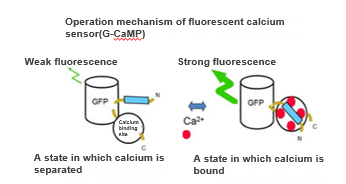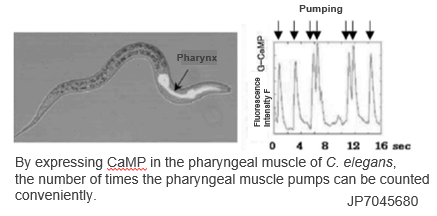High brightness fluorescent calcium sensor
Useful for elucidating various biological mechanisms involving calcium ions
Overview
The inventors have previously developed G-CaMP and R-CaMP (CaMP) as proteinaceous fluorescent calcium sensors.
By introducing CaMP into a cell, the location of the cell can be identified and changes in calcium ion concentration can be observed as changes in CaMP fluorescence intensity.
・G-CaMP7, G-CaMP7.09: Displays green fluorescence.
・R-CaMP1.07: Displays red fluorescence and can be used in combination with the photo-stimulation probe Channelrhodopsin-2, which is commonly used for cell function manipulation.

Application: Methods for evaluating the bioactivity of drugs using nematodes

Product Application
・Elucidation of biological mechanisms
・Visualization of brain activity
・Observation of electrical coupling between transplanted cells and existing cells
Related Works
[1] 64 | VOL.12 NO.1 | JANUARY 2015 | nature methods
[2] PLoS One. 2015 May 6;10(5):e0125354
[3] 388| NATURE | VOL 538 | 20 october 2016
IP Data
IP No. : JP5669080, 7045680, JP6051438, JP6971461, JP5788160
Inventor : NAKAI Junichi
keyword : calcium、biosensor、Neuroscience
